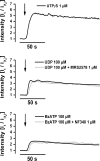Purine receptors and Ca(2+) signalling in the human blood-brain barrier endothelial cell line hCMEC/D3
- PMID: 21956217
- PMCID: PMC3286539
- DOI: 10.1007/s11302-011-9262-7
Purine receptors and Ca(2+) signalling in the human blood-brain barrier endothelial cell line hCMEC/D3
Abstract
The expression and physiology of purine receptors of the human blood-brain barrier endothelial cells were characterised by application of molecular biological, gene-silencing and Ca(2+)-imaging techniques to hCMEC/D3 cells. Reverse transcription polymerase chain reaction showed the expression of the G-protein-coupled receptors P2Y(2)-, P2Y(6)-, P2Y(11)- as well as the ionotropic P2X(4)-, P2X(5)- and P2X(7)-receptors. Fura-2 ratiometry revealed that adenosine triphosphate (ATP) or uridine triphosphate (UTP) mediated a change in the intracellular Ca(2+) concentration ([Ca(2+)](i)) from 150 to 300 nM in single cells. The change in [Ca(2+)](i) corresponded to a fourfold to fivefold increase in the fluorescence intensity of Fluo-4, which was used for high-throughput experiments. Pharmacological dissection using different agonists [UTPγS, ATPγS, uridine diphosphate (UDP), adenosine diphosphate (ADP), BzATP, αβ-meATP] and antagonist (MRS2578 or NF340) as well as inhibitors of intracellular mediators (U73122 and 2-APB) showed a PLC-IP(3) cascade-mediated Ca(2+) release, indicating that the nucleotide-induced Ca(2+) signal was mainly related to P2Y(2, 6 and 11) receptors. The gene silencing of the P2Y(2) receptor reduced the ATP- or UTP-induced Ca(2+) signal and suppressed the Ca(2+) signal mediated by P2Y(6) and P2Y(11) more specific agonists like UDP (P2Y(6)), BzATP (P2Y(11)) and ATPγS (P2Y(11)). This report identifies the P2Y(2) receptor subtype as the main purine receptor involved in Ca(2+) signalling of the hCMEC/D3 cells.
Figures





References
LinkOut - more resources
Full Text Sources
Miscellaneous

